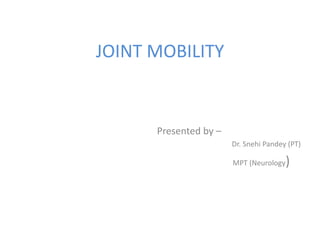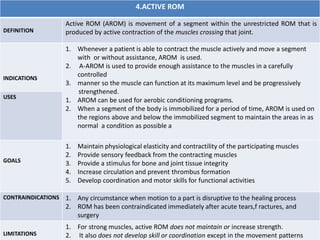Joint mobility . copy
- 1. JOINT MOBILITY Presented by â Dr. Snehi Pandey (PT) MPT (Neurology)
- 2. JOINT MOBILITY Contents 1. Definition 2. Causes of limitation 3. Types 4. indication and contraindications 5. Principles ,preparation and application 6. Technique 7. PROM for Individual joint.
- 3. 1.DEFINITION OF MOBILITY: âĒ The ability of structures or segments of the body to move or be moved in order to allow the occurrence of range of motion (ROM) for functional activities (functional ROM). âĒ Passive mobility is dependent on soft tissue (contractile and non contractile) extensibility; in addition, active mobility requires neuromuscular activation.
- 4. 2.CAUSES OF LIMITATION (1) Prolonged immobilization of a body segment (2) Sedentary lifestyle, (3) Postural malalignment and muscle imbalances, (4) Impaired muscle performance (weakness) associated with an array of musculoskeletal or neuromuscular disorders, (5) Tissue trauma resulting in inflammation and pain, and (6) Congenital or acquired deformities.
- 5. TYPES Active range of motion exercises Passive range of motion exercise Active assisted range of motion exercise 3.TYPES
- 6. 4.ACTIVE ROM DEFINITION Active ROM (AROM) is movement of a segment within the unrestricted ROM that is produced by active contraction of the muscles crossing that joint. INDICATIONS 1. Whenever a patient is able to contract the muscle actively and move a segment with or without assistance, AROM is used. 2. A-AROM is used to provide enough assistance to the muscles in a carefully controlled 3. manner so the muscle can function at its maximum level and be progressively strengthened. 1. AROM can be used for aerobic conditioning programs. 2. When a segment of the body is immobilized for a period of time, AROM is used on the regions above and below the immobilized segment to maintain the areas in as normal a condition as possible a USES GOALS 1. Maintain physiological elasticity and contractility of the participating muscles 2. Provide sensory feedback from the contracting muscles 3. Provide a stimulus for bone and joint tissue integrity 4. Increase circulation and prevent thrombus formation 5. Develop coordination and motor skills for functional activities CONTRAINDICATIONS 1. Any circumstance when motion to a part is disruptive to the healing process 2. ROM has been contraindicated immediately after acute tears,f ractures, and surgery LIMITATIONS 1. For strong muscles, active ROM does not maintain or increase strength. 2. It also does not develop skill or coordination except in the movement patterns
- 7. 4.PASSIVE ROM DEFINITION Passive ROM (PROM) is movement of a segment within the unrestricted ROM that is produced entirely by an external force; there is little to or no voluntary muscle contraction. INDICATIONS 1. In the region where there is acute, inflamed tissue, passive motion is beneficial active motion would be detrimental to the healing process. Inflammation after injury or surgery usually lasts 2 to 6 days. 2. When a patient is not able to or not supposed to actively move a segment or segments of the body, as when comatose, paralyzed, or on complete bed rest, movement is provided by an external source. 1. Maintain joint and connective tissue mobility 2. Minimize the effects of the formation of contractures 3. Maintain mechanical elasticity of muscle 4. Assist circulation and vascular dynamics 5. Enhance synovial movement for cartilage nutrition and 6. diffusion of materials in the joint 7. Decrease or inhibit pain 8. Assist with the healing process after injury or surgery 9. Help maintain the patientâs awareness of movement. GOALS OTHER USES 1. When a therapist is examining inert structures, PROM is used to determine limitations of motion, to determine joint stability and to determine muscle and other soft tissue elasticity. 2. When a therapist is teaching an active exercise program, PROM is used to demonstrate the desired motion. 3. When a therapist is preparing a patient for stretching, PROM is often used preceding the passive stretching techniques. CONTRAINDICATIONS 1. ROM has been contraindicated immediately after acute tears, fractures, and surgery; PRECAUTIONS 1. Signs of too much or the wrong motion include increased pain and inflammation.
- 8. 1.Examine and evaluate the patientâs impairments and level of function, determine any precautions and prognosis, and plan the intervention. 2.Determine the ability of the patient to participate in the ROM activity and whether PROM, A-AROM, or AROM can meet the immediate goals. 5.PRINCIPLES FOR APPLYING ROM EXERCISES
- 9. 3. Determine the amount of motion that can be safely applied for the condition of the tissues and health of the individual. 4. Decide what Decide what patterns can best meet the goals. ROM techniques may be performed in the a. Anatomic planes of motion: frontal, sagittal, transverse b. Muscle range of elongation: antagonistic to the line of pull of the muscle c. Combined patterns: diagonal motions or movements that incorporate several planes of motion d. Functional patterns: motions used in activities of daily living (ADL)
- 10. 5.Monitor the patientâs general condition and response during and after the examination and intervention; note any change in vital signs, any change in the warmth and color of the segment, and any change in the ROM, pain, or quality of movement. 6.Document and communicate findings and intervention 7.Re-evaluate and modify the intervention As necessary
- 11. Position the patient in a comfortable position with proper body alignment and stabilization Preparation Position yourself so proper body mechanics can be used. Free the region from restrictive clothing, linen, splints, and dressings Communicate with the patient, explain plan and method of treatment
- 12. 1.To control movement, grasp the extremity around the joints. If the joints are painful, modify the grip, still providing support necessary for control 2. Support areas of poor structural integrity, such as a hyper mobile joint, recent fracture site, or paralyzed limb segment. 3. Move the segment through its complete pain-free range to the point of tissue resistance. Do not force beyond the available range. If you force motion, it becomes a stretching technique 4. Perform the motions smoothly and rhythmically, with 5 to 10 repetitions. The number of repetitions depends on the objectives of the program and the patientâs condition and response to the treatment 6.APLLICATION OF TECHNIQUE -
- 13. Application of AROM 1. Demonstrate the motion desired using PROM; then ask the patient to perform the motion. Have your hands in position to assist or guide the patient if needed. 2. Provide assistance only as needed for smooth motion. When there is weakness, assistance may be required only at the beginning or the end of the ROM, or when the effect of gravity has the greatest moment arm (torque). 3. The motion is performed within the available ROM
- 14. Application of PROM 1. During PROM the force for movement is external, being provided by a therapist or mechanical device. When appropriate, a patient may provide the force and be taught to move the part with a normal extremity. 2. No active resistance or assistance is given by the patientâs muscles that cross the joint. If the muscles contract, it becomes an active exercise. 3. The motion is carried out within the free ROM, that is, the range that is available without forced motion or pain.
- 15. 7.PROM FOR INDIVIDUAL JOINT.
- 50. REFERENCE â CAROLY KISNER ,THERAPEUTIC EXERCISE, 5TH EDITION.
- 51. THANK YOU


















































